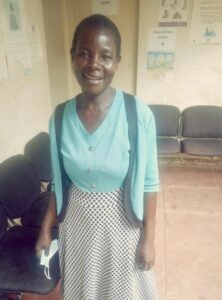This is a two-part series on vaccine delivery and distribution. Read the companion article here.

As a Community Health Volunteer (CHV) near Kisumu, Kenya, Rose Obongo is part of the very backbone of the healthcare system. She, like other CHVs, have been working closely with governments and non-governmental organizations to keep their communities healthy for decades. Rose will play an essential frontline role as the COVID-19 vaccine is rolled out in her community. Read on to find out how.
CHVs – the majority of whom are women – connect community members to important health services and information. A key part of their success is that they are trusted members of the community from the very beginning.
Rose was nominated by her neighbours at a community meeting called a baraza nearly 10 years ago. Since then, she has been visiting hundreds of households every month to make sure everyone is healthy and equipped with knowledge about the health services available to help them thrive.
“There are so many things happening in people’s homes that staff working at a health centre cannot know about,” says Rose. By visiting them on a regular basis and building trusting relationships with community members, she is able to understand their healthcare needs and direct them to the right services. How does she do that? “You befriend them. You love them. You talk to them deeply and you really consider what they’re going through.”
The mutual respect and trust Rose builds with community members makes her uniquely placed to exchange sensitive information with them in a way that ensures they feel more comfortable seeking available healthcare opportunities.
A key responsibility of a Community Health Volunteer is to make sure that children are receiving routine immunizations that protect them against diseases like measles or polio. They check immunization cards when they visit families to ensure that everyone is vaccinated, helping to prevent outbreaks and reduce preventable illness and death. If Rose meets a child whose routine immunizations aren’t up to date, she is happy to accompany both mother and baby to the clinic and walk the family through the process of immunization.
When a case of polio was recently detected in a neighbouring county, Community Health Volunteers sprang into action as part of a widespread public engagement campaign. Health information was broadcast on the radio while CHVs visited homes to make sure immunization cards were up to date, they got people to vaccination clinics, and they shared trusted information about polio to curb its spread and prevent an outbreak.
This kind of strong expertise in vaccine rollout has already been built around the world. However, less than 2 percent of COVID-19 vaccines have been delivered to African countries. In addition to procurement challenges, persistent barriers exist that prevent vaccines from reaching rural communities as effectively as possible. For example, weak supply chains and cold chains make it difficult to safely store and deliver vaccines everywhere they need to go, and lack of evidence-based information results in vaccine hesitancy.
CARE Canada estimates that for every $1 invested in vaccine doses, $5 must be invested to get the vaccines to communities. These costs include training, equipping and supporting health workers, as well as strengthening supply chains and healthcare systems to ensure no communities are left behind.
Canada’s investment in the delivery of COVID-19 vaccines to more people, faster, will save lives both now and in the future. Faster, more widespread delivery will slow the spread of variants, plus stronger health systems will place countries in a better position to handle future pandemics and facilitate more effective routine immunizations well beyond this moment of crisis.
As Kenyans wait for COVID-19 vaccines to become more widely available, Rose is often asked about them and she is pleased that the community’s interest in receiving the vaccine seems to be high. When someone expresses concerns or hesitations, Rose proudly shares her own experience receiving her first dose of the AstraZeneca vaccine. She explains the mild side effects she experienced, and how to deal with them. Evidence suggests that people’s trust in health care workers is one of the most important factors in improving vaccine uptake, more than the opinions of family, friends or other non-medical sources.
Thanks to the meaningful relationships Rose has established in the community through her years of service, people listen to her, trust her, and are far more likely to want the vaccine when it is available. She cares deeply about her community and can’t wait for more COVID-19 vaccines to reach them. Community Health Volunteers are the essential link between communities and health systems, and the key to vaccines successfully reaching the most rural and isolated communities.
To learn more about the process a vaccine goes through before it arrives in rural communities like Rose’s community, read this blog!